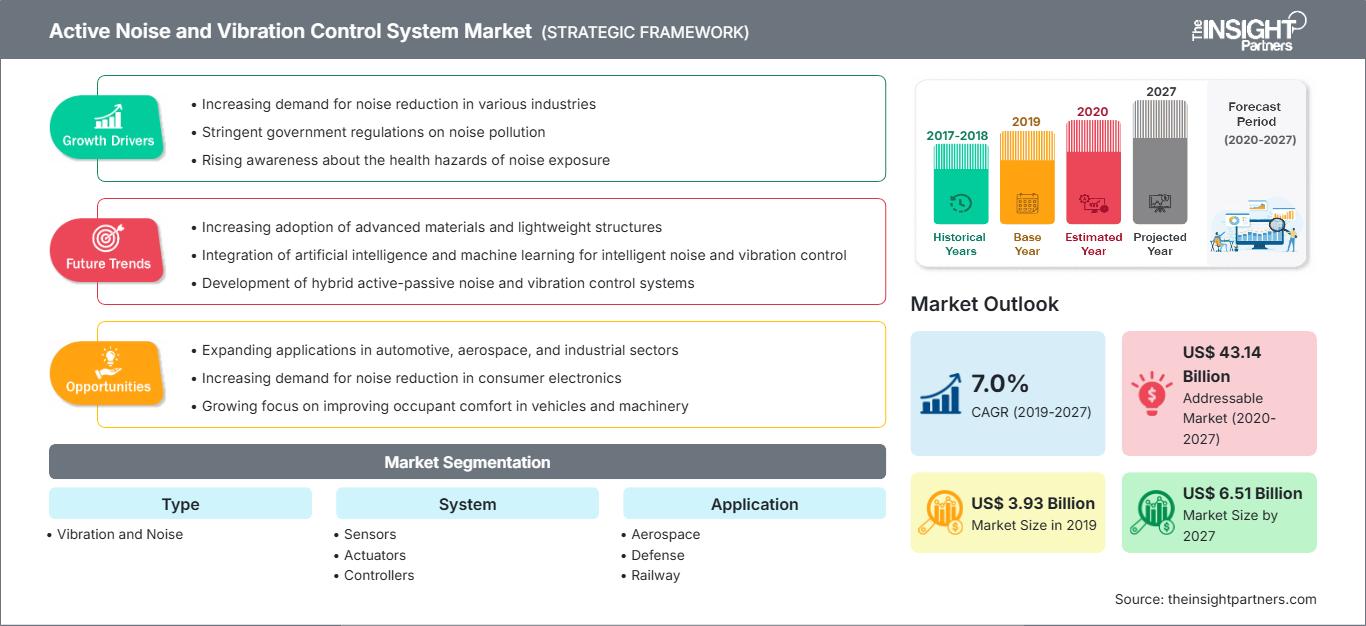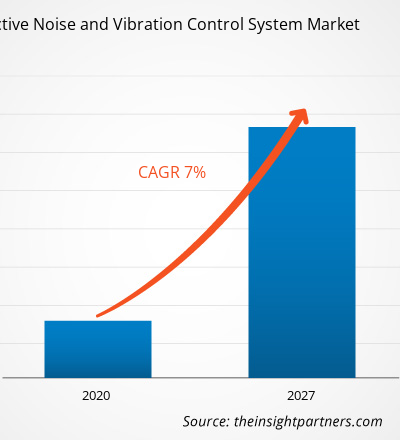Il mercato dei sistemi di controllo attivo del rumore e delle vibrazioni è ampiamente segmentato in cinque regioni principali: Nord America, Europa, APAC, MEA e SAM. L'industria aerospaziale e della difesa in Nord America è maturata grazie all'esistenza di un gran numero di produttori di aeromobili e al supporto continuo del Dipartimento della Difesa statunitense. La domanda di tecnologie avanzate è enorme nella regione, e tutti gli utenti finali sopra menzionati sono ben consapevoli delle nuove tecnologie. Il Dipartimento della Difesa statunitense investe costantemente tempo e risorse per il progresso della flotta esistente e lo sviluppo di veicoli blindati terrestri e navali tecnologicamente avanzati, con l'obiettivo di mantenere una forza pronta per la missione. La presenza di un gran numero di produttori di sistemi di controllo attivo del rumore e delle vibrazioni nella regione sostiene la domanda in continua crescita, che a sua volta stimola il mercato dei sistemi di controllo attivo del rumore e delle vibrazioni.
Personalizza questo rapporto in base alle tue esigenze
Potrai personalizzare gratuitamente qualsiasi rapporto, comprese parti di questo rapporto, o analisi a livello di paese, pacchetto dati Excel, oltre a usufruire di grandi offerte e sconti per start-up e università
Mercato dei sistemi di controllo attivo del rumore e delle vibrazioni: Approfondimenti strategici

- Ottieni le principali tendenze chiave del mercato di questo rapporto.Questo campione GRATUITO includerà l'analisi dei dati, che vanno dalle tendenze di mercato alle stime e alle previsioni.
Approfondimenti di mercato: il mercato dei sistemi di controllo attivo del rumore e delle vibrazioni sta aumentando l'adozione di sistemi attivi nella produzione ferroviaria
Potrai personalizzare gratuitamente qualsiasi rapporto, comprese parti di questo rapporto, o analisi a livello di paese, pacchetto dati Excel, oltre a usufruire di grandi offerte e sconti per start-up e università
Mercato dei sistemi di controllo attivo del rumore e delle vibrazioni: Approfondimenti strategici

- Ottieni le principali tendenze chiave del mercato di questo rapporto.Questo campione GRATUITO includerà l'analisi dei dati, che vanno dalle tendenze di mercato alle stime e alle previsioni.
Il settore ferroviario in tutto il mondo sta crescendo a un ritmo considerevole nel corso degli anni, con diversi progressi tecnologici in corso che riflettono viaggi più sicuri e confortevoli. Le apparecchiature ferroviarie (carrelli e carrelli di carico) sono soggette a significative vibrazioni verticali e rumore, che aumentano diversi tipi di rischio durante il funzionamento. Per ridurre vibrazioni e rumore, diversi produttori di apparecchiature ferroviarie si stanno concentrando sempre più sull'adozione di sistemi di controllo del rumore e delle vibrazioni. Il controllo passivo del rumore e delle vibrazioni è prevalente tra i produttori ferroviari, poiché questi sistemi consentono loro di offrire ai propri clienti prodotti più sicuri e confortevoli. Tuttavia, la maggior parte dei sistemi passivi è costituita da sistemi idraulici e, negli ultimi anni, i produttori di apparecchiature ferroviarie stanno puntando su sistemi a controllo elettronico/elettrico, il che riflette la crescente attrazione verso i sistemi attivi di controllo del rumore e delle vibrazioni. Un sistema attivo con attuatori a massa inerziale montati sui carrelli può controllare il rumore e le vibrazioni a bassa frequenza all'interno dei compartimenti. Inoltre, i sistemi attivi sono generalmente sistemi elettromeccanici, che stanno diventando la scelta principale tra i produttori di apparecchiature ferroviarie. Si prevede che questo fattore genererà una domanda significativamente maggiore di sistemi attivi tra i produttori di apparecchiature ferroviarie, catalizzando così il mercato dei sistemi di controllo attivo del rumore e delle vibrazioni.
Approfondimenti sul segmento di tipologia
In base alla tipologia, il segmento delle vibrazioni ha dominato il mercato globale dei sistemi di controllo attivo del rumore e delle vibrazioni nel 2019. I sistemi di controllo attivo delle vibrazioni sono sistemi di isolamento che rispondono dinamicamente alle vibrazioni esterne. Questi sistemi vengono utilizzati per ridurre l'attrito e controllare le vibrazioni nelle macchine in movimento o statiche.
Approfondimenti sul segmento di sistema
In base al sistema, il segmento degli attuatori ha dominato il mercato globale dei sistemi di controllo attivo del rumore e delle vibrazioni nel 2019. Gli attuatori sono integrati nei sistemi di controllo attivo del rumore e delle vibrazioni per controllare le varie forze all'interno dell'impianto e migliorarne il funzionamento complessivo. Questi attuatori utilizzano diverse tecnologie, come quella piezoelettrica, elettrodinamica e idraulica.
Approfondimenti sui segmenti di settore
In base al settore, nel 2019 il settore aerospaziale ha dominato il mercato globale dei sistemi di controllo attivo del rumore e delle vibrazioni. L'industria aerospaziale sta prosperando a un ritmo esponenziale nel corso degli anni, con un gran numero di produzioni e consegne. I produttori di aeromobili e di componenti stanno subendo forti pressioni da parte degli utenti finali del settore dell'aviazione commerciale affinché forniscano un numero maggiore di aeromobili.
Gli operatori del mercato si concentrano su innovazioni e sviluppi di nuovi prodotti integrando tecnologie e funzionalità avanzate nei loro prodotti per competere con i concorrenti.
- Nel 2019, Creo Dynamics ha annunciato l'acquisizione della sua quota di maggioranza da parte di Faurecia, per unire la competenza dell'azienda nel controllo attivo del rumore e nell'acustica automobilistica con Faurecia e sviluppare nuove soluzioni esclusive per il mercato.
- Nel 2019, Terma ha annunciato di aver firmato un contratto con UASF per la fornitura di sistemi audio 3D per gli aerei A-10.
- Nel 2018, Vicoda GmbH ha annunciato di aver fornito smorzatori di massa accordati per passerelle pedonali a Gent per controllare e ridurre le vibrazioni indotte dai pedoni e soddisfare i requisiti di comfort impedendo il "lock-in" effetto.
Il mercato globale dei sistemi di controllo attivo del rumore e delle vibrazioni è stato segmentato come segue:
Mercato dei sistemi di controllo attivo del rumore e delle vibrazioni
Le tendenze regionali e i fattori che influenzano il mercato dei sistemi di controllo attivo del rumore e delle vibrazioni durante il periodo di previsione sono stati ampiamente spiegati dagli analisti di The Insight Partners. Questa sezione illustra anche i segmenti di mercato e la distribuzione geografica dei sistemi di controllo attivo del rumore e delle vibrazioni in Nord America, Europa, Asia-Pacifico, Medio Oriente e Africa, America meridionale e centrale.
Ambito del rapporto di mercato sui sistemi di controllo attivo del rumore e delle vibrazioni
| Attributo del rapporto | Dettagli |
|---|---|
| Dimensioni del mercato in 2019 | US$ 3.93 Billion |
| Dimensioni del mercato per 2027 | US$ 6.51 Billion |
| CAGR globale (2019 - 2027) | 7.0% |
| Dati storici | 2017-2018 |
| Periodo di previsione | 2020-2027 |
| Segmenti coperti |
By Tipo
|
| Regioni e paesi coperti | Nord America
|
| Leader di mercato e profili aziendali chiave |
|
Densità degli operatori del mercato dei sistemi di controllo attivo del rumore e delle vibrazioni: comprendere il suo impatto sulle dinamiche aziendali
Il mercato dei sistemi di controllo attivo del rumore e delle vibrazioni è in rapida crescita, trainato dalla crescente domanda degli utenti finali, dovuta a fattori quali l'evoluzione delle preferenze dei consumatori, i progressi tecnologici e una maggiore consapevolezza dei vantaggi del prodotto. Con l'aumento della domanda, le aziende stanno ampliando la propria offerta, innovando per soddisfare le esigenze dei consumatori e sfruttando le tendenze emergenti, alimentando ulteriormente la crescita del mercato.

- Ottieni il Mercato dei sistemi di controllo attivo del rumore e delle vibrazioni Panoramica dei principali attori chiave
- Vibrazione
- Rumore
Mercato dei sistemi di controllo attivo del rumore e delle vibrazioni - Per sistema
- Sensori
- Attuatori
- Controller
- Smorzatori
Mercato dei sistemi di controllo attivo del rumore e delle vibrazioni - Per sistema
- Aerospaziale
- Ala fissa
- Ala rotante
- Difesa
- Veicoli terrestri
- Navi militari
- Ferrovie
- Industrie generali
- Produzione
- Energia e Potenza
Mercato dei sistemi di controllo attivo del rumore e delle vibrazioni – Per sistema
- Sensori
- Attuatori
- Controller
- Smorzatori
Mercato dei sistemi di controllo attivo del rumore e delle vibrazioni - Per regione
- Nord America
- Stati Uniti
- Canada
- Messico
- Europa
- Francia
- Germania
- Italia
- Regno Unito
- Russia
- Resto d'Europa
- Asia Pacifico (APAC)
- Cina
- India
- Corea del Sud
- Giappone
- Australia
- Resto dell'APAC
- Medio Oriente e Africa (MEA)
- Sudafrica
- Arabia Saudita Arabia
- Emirati Arabi Uniti
- Resto del MEA
- Sud America (SAM)
- Brasile
- Resto del SAM
Mercato dei sistemi di controllo attivo del rumore e delle vibrazioni: Profili aziendali
- FABREEKA
- Honeywell International Inc.
- HUTCHINSON
- Terma A/S
- Moog Inc.
- Parker Hannifin
- Faurecia Creo AB
- Supashock
- Trelleborg AB
- VICODA GmbH
- Analisi storica (2 anni), anno base, previsione (7 anni) con CAGR
- Analisi PEST e SWOT
- Valore/volume delle dimensioni del mercato - Globale, Regionale, Nazionale
- Industria e panorama competitivo
- Set di dati Excel
Report recenti
Testimonianze
Motivo dell'acquisto
- Processo decisionale informato
- Comprensione delle dinamiche di mercato
- Analisi competitiva
- Analisi dei clienti
- Previsioni di mercato
- Mitigazione del rischio
- Pianificazione strategica
- Giustificazione degli investimenti
- Identificazione dei mercati emergenti
- Miglioramento delle strategie di marketing
- Aumento dell'efficienza operativa
- Allineamento alle tendenze normative






















 Ottieni un campione gratuito per - Mercato dei sistemi di controllo attivo del rumore e delle vibrazioni
Ottieni un campione gratuito per - Mercato dei sistemi di controllo attivo del rumore e delle vibrazioni